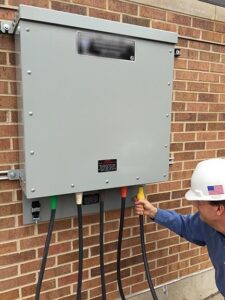Having reliable sources of electrical power has become a critical part of what we do. Our daily lives have become so dependent on having places to plug in that many of us would be absolutely lost if the electricity stopped flowing. For most people, a brief loss of power while at home or even at the office is at most an inconvenience. However, there are many facilities where having continuous power is critical to their operations. For food storage, reliable power keeps refrigeration equipment running which minimizes loss of products. For a data center, reliable power prevents loss of information. For a health care facility, reliable power sustains lives.
In facilities where reliable power is critical, there is often a generator and transfer switch (or perhaps several) to provide backup power to all or part of the building. When a power outage occurs, the generator automatically starts and takes over feeding power where it is needed. Having a generator connected to your facility greatly improves the reliability of your power system – but it’s not perfect. A generator is a machine, and sometimes machines break down and require maintenance. If your generator requires maintenance, repair, or even replacement, it would be helpful to have a simple way to bring in an alternate backup power source and plug it in, just in case.
The 2017 National Electric Code, section 700.3(F), addresses this with a new requirement. It states that a facility that relies on a single alternate source of power must have a permanent means to connect a temporary alternate source in case the permanent source (i.e., generator) requires maintenance or repair. It also outlines the requirements for the means of connection. In other words, if your generator must be offline for any reason, you need to be able to plug in a portable generator to back up your facility. And this connection must be able to be done without rewiring or otherwise modifying the building power distribution system.
This requirement can be satisfied simply with a Generator Connection Panel – sometimes called a Generator Docking Station or Generator Tap Box – that is integral to your facility. Typically, this consists of a box mounted on the exterior of the building with a series of connectors for flexible cabling from the portable generator. This box is then connected to the emergency power system through a manual transfer switch that allows you to select either the permanent generator or the portable one. It is a simple but important feature that bridges a critical gap in your emergency power system.

If continuous power is critical to the operation of your facility, let us evaluate your building’s electrical system and recommend a backup power solution that works for you. Please contact Richard I. Koval, PE, LEED AP at 814-237-2180, or rik@ba-inc.com.